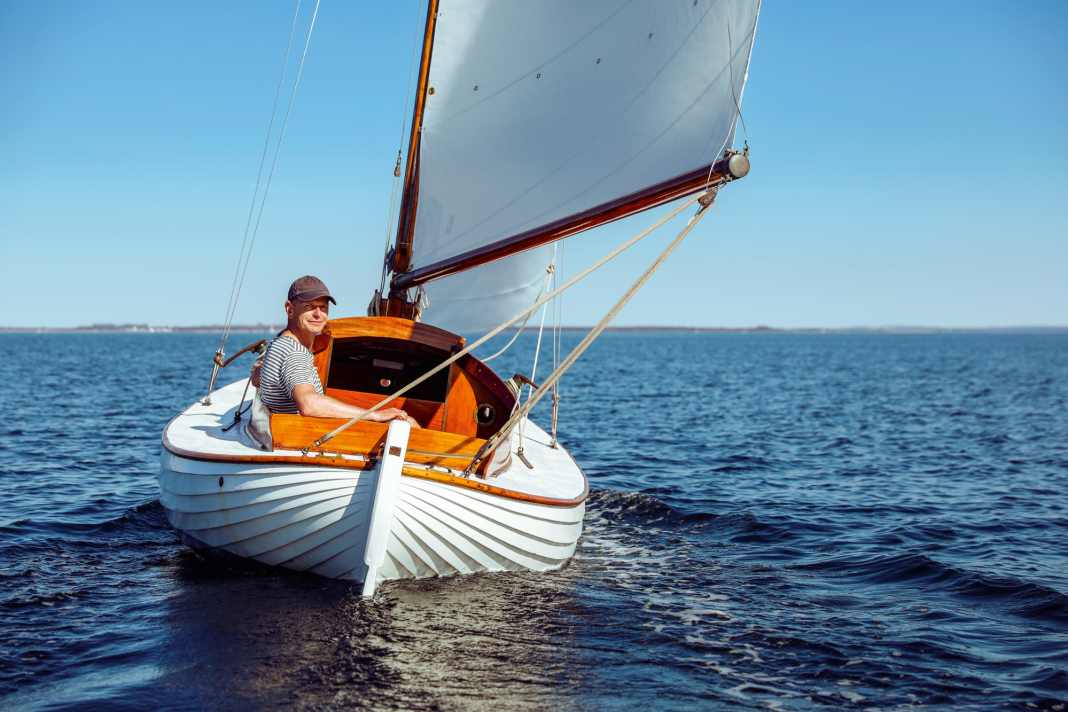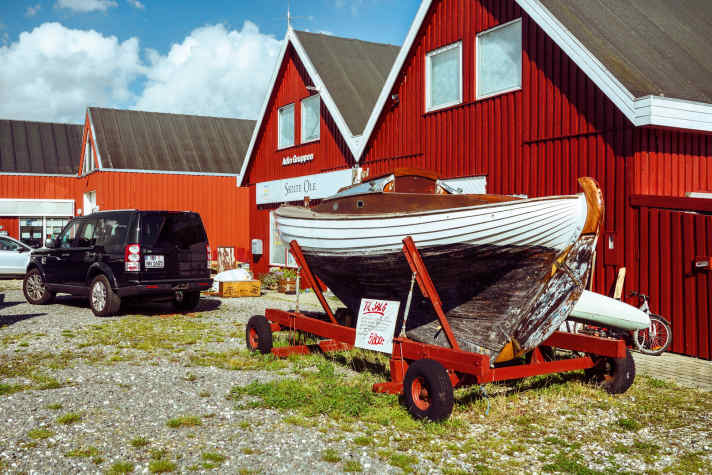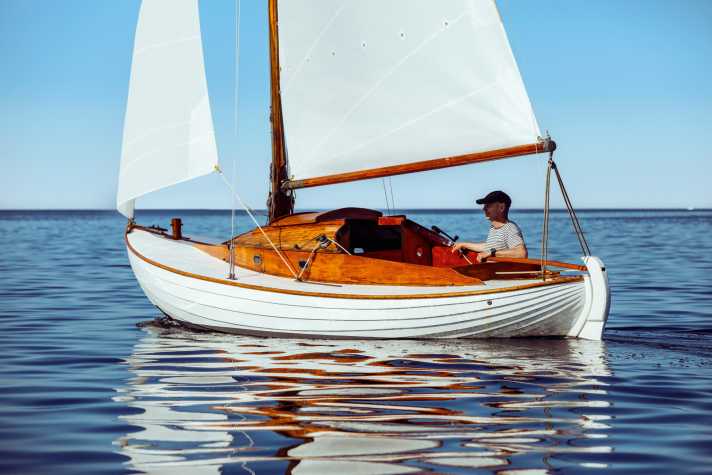





Copenhagen in late summer 2015: Mare TV is filming a documentary about the happy inhabitants of the harbour metropolis on the Øresund. In addition to a mussel farmer and an elderly lady who swims her laps in the harbour basin, Jochen Gaßner, owner of a three-storey garage for motorboats, is also portrayed. The German emigrant himself owns an old gaff cutter, on which he invites the film crew for a little after-work cruise. Cameraman Florian Melzer is delighted with the restored piece of jewellery from the 1930s. "You can buy something like this here, most Danes want to get rid of their wooden boats," says Gaßner.
The next day, the two of them are standing in front of an old 20something classroom gate in Ishøj, near the Danish capital. With his screwdriver, the Dane-by-choice nods at the wood: "Yeah, not bad. You can do it!" Melzer feels a little taken by surprise and thinks he's in the wrong film. Gaßner had literally chatted him up, and at first glance this object had more in common with a wooden shed than a sailing boat. "Leave it alone," he says to himself, "just leave it alone." He has never owned his own boat, and he can't sail either.
The cameraman becomes a boat owner for 770 euros
The filmmaker built model sailing boats with his grandfather as a child and has been fascinated by the aesthetics of classic yachts ever since - but taking on such a project without any experience? "This little treasure was built in 1946 and is an absolute rarity - designed by M.S.J. Hansen," says the wife of the now bedridden owner. M.S.J. who? The only thing that appeals to Melzer about the boat at this point is its price: 5,800 crowns, the equivalent of around 770 euros.
But "Hængi", as the boat is called, never lets him go. Melzer researches the fact that Marius Sofus Johannes Hansen, his full name, was one of Denmark's most famous boat designers in the thirties and forties, alongside Aage Utzon. While Utzon designed the fastest pointed gates, Hansen had a reputation for drawing the most beautiful ones. Although some of these have survived to this day, a second 20-class pointed gate has not.
Two days later, on the way home to Hamburg, the decision has to be made before the idea threatens to get bogged down in everyday life. Melzer remembers his ambivalent feelings: "I'd been dreaming of restoring an old sailing boat for ages. On the other hand, I spent six months a year travelling for work and had no idea what I was getting myself into. But I also didn't always want to just film other people's beautiful things, I wanted to do something for myself." Shortly before Hamburg, Melzer took heart and agreed by phone. Let the adventure begin!

Hængi means: Don't give up. Keep at it. Do your best!
A week later, the Spitzgatter and its thoroughly rusted harbour trailer are placed on a trailer and secured with straps and wedges to the best of our ability. There is also a box with the original fittings and a request to take good care of the boat. When asked what the name "Hængi" means, the owner's wife replies with both a smile and a warning: "Don't give up. Keep at it. Do your best!"
The transfer to winter storage in Wildeshausen, Lower Saxony, is the first test. Squalls and heavy rain showers regularly hit the fragile trailer, causing the new owner's nervousness to constantly rise. Again and again, the anxious look in the rear-view mirror to see whether the boat and trailer are not swaying. The fear is great - especially on the exposed belt bridges. But everything goes well. It is only during the final trailer manoeuvre that a mishap occurs when "Hængi's" rudder suspension punches a hole in the barn wall. "Well, then we finally have light in the barn," comments the owner dryly.
Many "experts" and many opinions on restoration
The first realisation that the completely inexperienced restorer will make is that there are not only many experts, but also many opinions. But whose voice should he listen to? An acquaintance of his father, a boat builder from southern Germany, had suggested splinting the broken frames with 12 to 14 millimetre thick marine plywood. Full of vigour, Melzer gets into the boat, makes a template out of cardboard for each frame, then saws out the reinforcements from plywood he has bought himself and fits them carefully. He proudly sends photos of his first work to Gaßner in Copenhagen. "Nice model. Now you can go into the forest with it and look for a decent piece of wood to start all over again." Once this reaction has served him well, Melzer leaves the plywood in the boat for the time being. Until the next boat builder comes along and suggests that he go into the forest and look for wood. Eventually, Melzer finds some suitable oak plywood, which gets the thumbs up from two boat builders.
Two other tips prove to be valuable in the long term. Firstly, to keep the costs low so as not to jeopardise the project. And secondly, not to restore the boat to ruin, but to save everything that is still usable.
Weeks, months and years go by. And whenever Florian Melzer finds time between his filming trips, he travels from Hamburg to his boat in Wildeshausen. He spends most of his time sanding and painting, with the help of his two children. However, he often just sits in front of it on a folding chair to look at it in peace and quiet. "You always just sit in front of your boat and don't do anything," one visitor says. "Yes, I have to look and realise it first. And who says it will ever be finished?"
The pointed gate makes for happy coincidences
During a film production in the Azores, the cameraman meets two blue-water sailors of very different colours at the legendary sailing meeting place "Peter Café Sport". The Grenadian solo sailor Joel Mark, who conquered the North Atlantic in a self-built nutshell, and the German Sven Junge, who was on a long voyage in a superbly equipped cruising yacht. And he asks the long-term restorer whether he wants to sail or tinker. Even if the question has a disrespectful undertone, it spurs Melzer on and reminds him of the meaning of "Hængi": Don't give up. Keep at it. Do your best!
Back at home, the project picks up speed again. As two 2.80 metre long planks have such large cracks that they need to be replaced, Melzer seeks the advice of renowned master boat builder Bernd Thal from Hamburg. Whilst inspecting the pointed gaff, he gets talking to Melzer's son Justus, who has just dropped out of school but still has no alternative in mind. Thal offers the talented young man the chance to help with the restoration of a Youth travelling cutter to get involved. The 16-year-old now works on the social project twice a week. This gives his life structure again and he feels valued. Motivated by this, he completed his vocational baccalaureate and began studying mechanical engineering in Leipzig. "Without 'Hængi', it certainly wouldn't have worked out so wonderfully," says his father with a wink. In the end, Melzer carefully removed the two torn planks from the hull himself, rivet by rivet, so that he could use them as a template for the new ones.
For three final years, the Danish clinker construction was finally moved to Bernd Thal's shipyard in Hamburg-Allermöhe. Even though the wooden boat specialist is on hand with help and advice, Melzer still has to gain his own experience and learn from his mistakes. "I never thought that restoring such a small boat would involve so much work, nor that you would learn so many new things about it. Boat paint, for example. For the last coat of paint, I first read through the accompanying booklet to learn how to dilute it so that it soaks in properly. In some places, you can still see the result of my ignorance at the time."

The sails are sewn from old pictures
As the boat is now outside, the weather also becomes a challenge. After the rubbing strakes have been painted several times and painstakingly refitted, it starts to rain and Melzer tries to protect his day's work with a tarpaulin. The next day, the tarpaulin sticks to the mouldings and the work starts all over again. However, there are no major disasters, even when nerves are frayed or the feeling of never being finished creeps in. "In spring, everyone else always went off into the water and went sailing, while I stayed in my chair." When the hull continued to dry out in the summer of 2022 and new cracks appeared in the wood, it became clear that it was high time to finally get "Hængi" back in the water. To prevent major damage, Melzer regularly wets the ship with a bucket.
As there are no longer any drawings or sail plans, the new cloths are sewn using the laylines resulting from the mast and boom and modelled on the old photos. Today, no one knows where the centrelines were positioned - they are set by feel. Even more creativity is required when the boat arrives at its new home harbour, Weiße Wiek in Boltenhagen, and a tarpaulin is urgently needed. As all the sailmakers are fully booked in the middle of the season, Melzer quickly buys waterproof fabric and takes it to the tailors who normally re-sew his trousers. After some back and forth, the tailors agree and sew a protective cover that looks good and fulfils its purpose, at least for the time being.
There is hardly a breath of wind during the trial run in the Bay of Wismar, and yet "Hængi" glides light as a feather over the water, which is also due to the fact that the interior is still missing. The splashing of the clinkered hull is pleasantly amplified by this hollow sound box and is the perfect background music for a sunny day's sailing. Even under engine power, the sound experience is not disturbed, as owner Melzer has opted for an electric outboard motor.
The pointed gate should remain spartan
The resurrected M.S.J. Hansen-Spitzgatter from 1946 now shines freshly restored in the brightest white with the proud owner. While the profile of the cuddly Dane resembles a pointed wooden shoe, the art of boat building is particularly evident at the stern, where the planks swing elegantly up to the sternpost, to which the rudder suspension fits snugly. "I can hardly believe that she really floats now. I was afraid that she would immediately sink," says Melzer.
The creative mind behind Mare TV doesn't yet know exactly what he plans to do with the boat in the future. "First of all, I want to learn to sail properly and then see where 'Hængi' takes me." Melzer laughs: "I first have to find out whether sailing is right for me in the long term. Next year, I'll approach it carefully and tackle longer trips." To this end, floorboards are to be built in the coming winter so that he can sleep on them. Plus a Trangia cooker, nothing more. It should remain Spartan.
"The journey here, with its endless beautiful and instructive afternoons, but also all those days in the dark season when I was all alone on the boat - it was a unique journey that I wouldn't want to miss!" Even though the work was a fixed point for the family and a good balance to his film trips, "Hængi" will probably remain a once-in-a-lifetime project for Melzer: "I wouldn't want to take on such an effort again. But if a fervent passion for sailing should really be unleashed and I remain faithful to my boat, then I will have a never-ending project ahead of me just to maintain it." Hængi - stay tuned!

